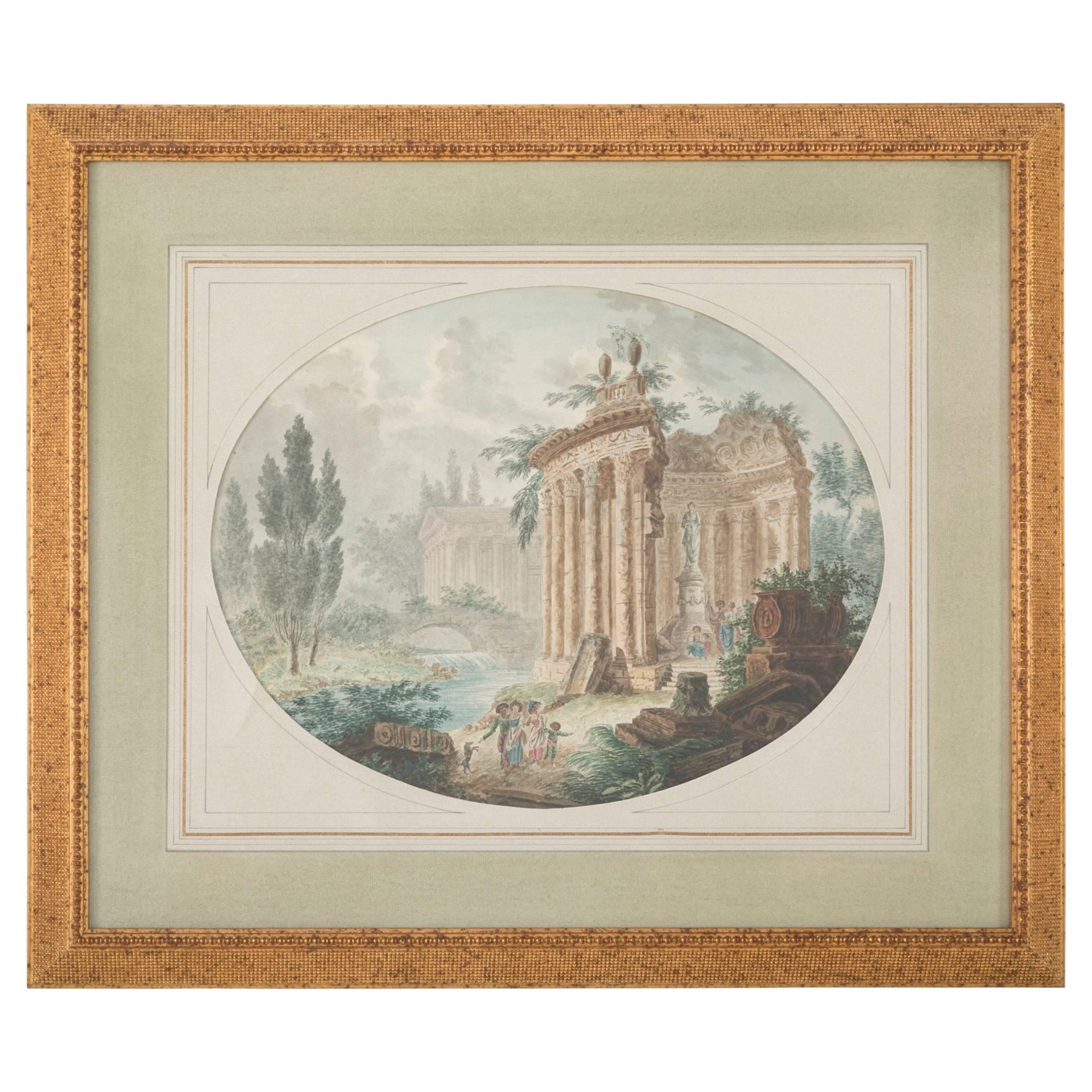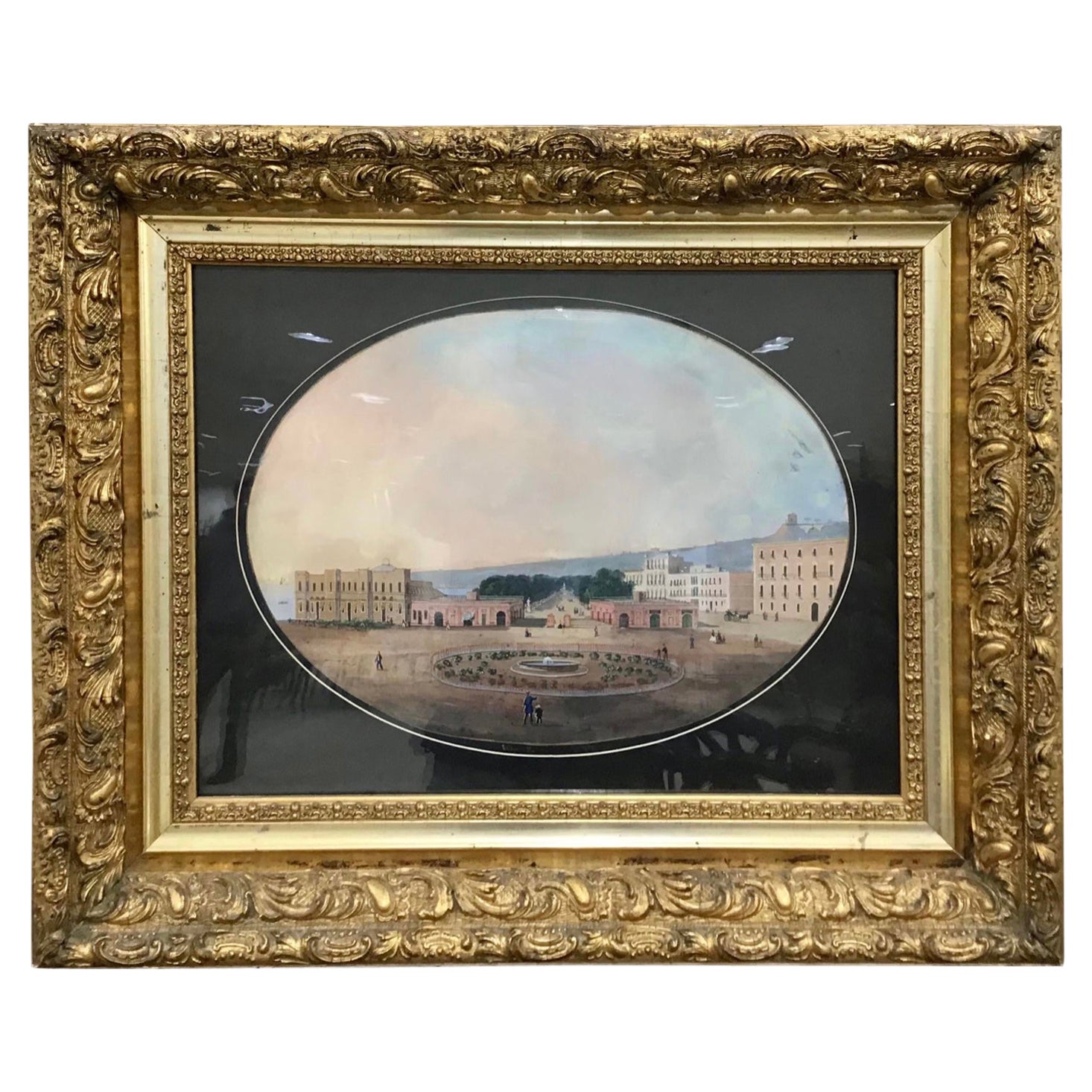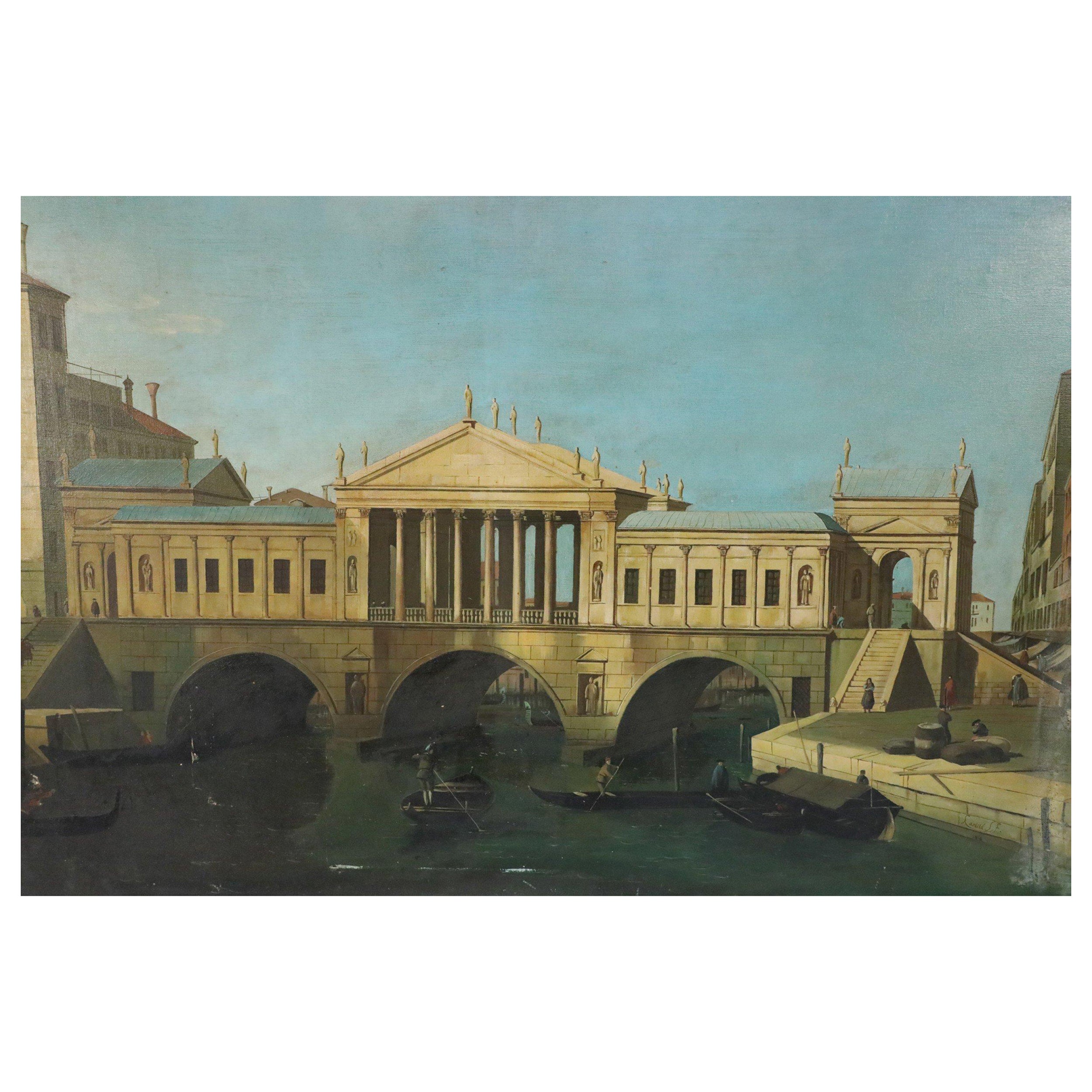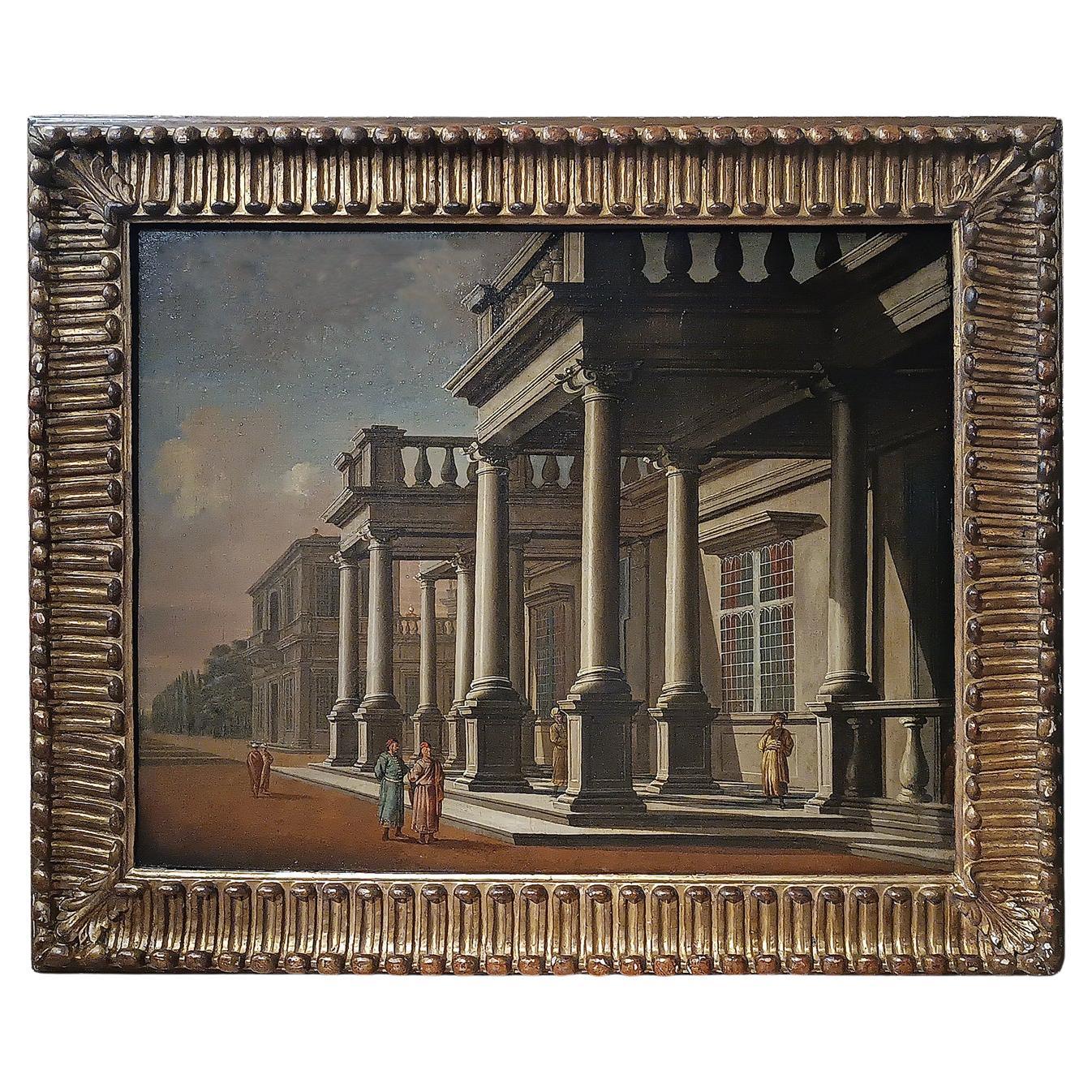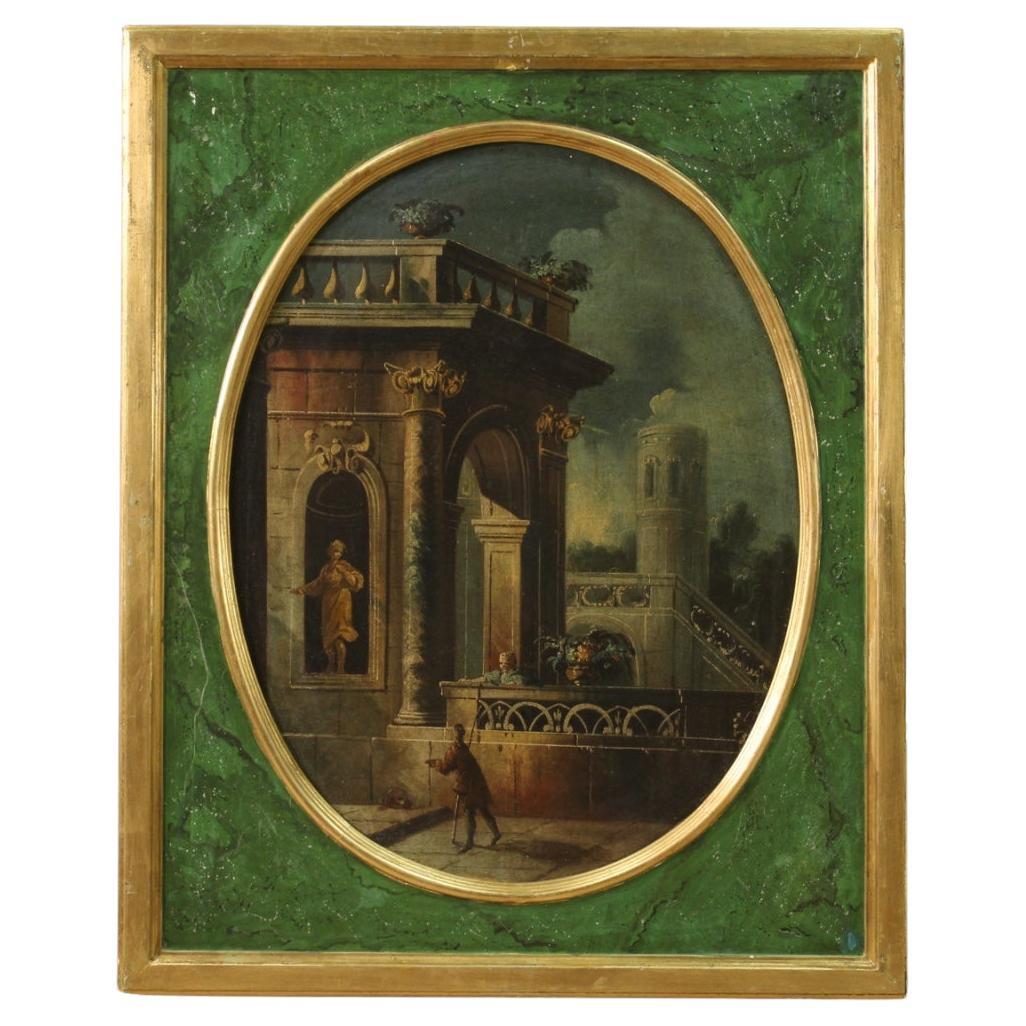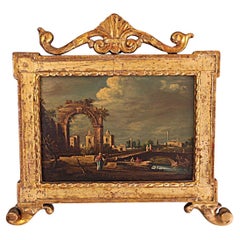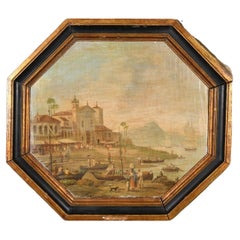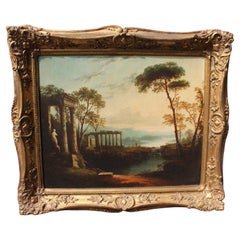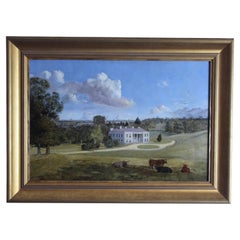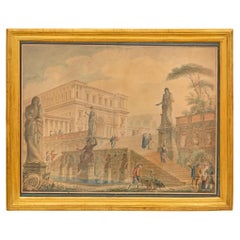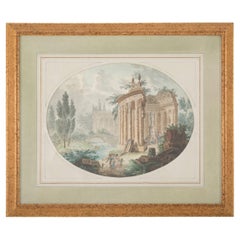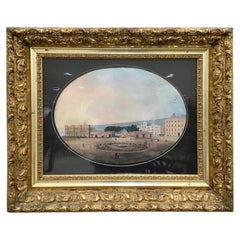Items Similar to 18th century Fine Italian Grand Tour gouache of Palladian Villa
Want more images or videos?
Request additional images or videos from the seller
1 of 8
18th century Fine Italian Grand Tour gouache of Palladian Villa
$2,112.15
£1,550
€1,826.83
CA$2,906.93
A$3,240.07
CHF 1,699.95
MX$39,566.56
NOK 21,525.12
SEK 20,344.51
DKK 13,634.44
About the Item
This fine 18th-century gouache on paper is a quintessential example of Grand Tour artistry, depicting an Italian Palladian villa rendered with architectural precision and classical restraint. Likely executed for an English aristocrat or scholar undertaking the Grand Tour, the work exemplifies the cultural appetite for classical forms and Enlightenment ideals that defined the period.
The villa’s façade is a study in symmetry and Palladian order — repetitive arched windows, rusticated stone details, and classical columns echo the neoclassical revival that swept through Europe in the wake of Andrea Palladio’s enduring influence. Its elegant proportions and measured rhythm embody the architectural ideals of balance and harmony, so sought after by 18th-century connoisseurs and architects alike.
Executed in gouache, the scene is rendered with a soft, matte surface that evokes both the serenity and the aged dignity of the structure. The medium’s delicacy allows subtle tonal shifts across stone surfaces and sky, lending the work an atmospheric quality consistent with its commemorative purpose.
Paintings such as this were commonly acquired during the Grand Tour — a rite of passage for the European elite — as visual mementoes of classical education and taste. These works, often commissioned from artists or purchased in Rome, Florence, or Venice, held pride of place in the libraries and salons of Georgian Britain and continental collectors alike.
This piece offers not just a window into 18th-century Italy but a tangible artefact of the era’s cultural exchange, merging travel, architecture, and the art of memory. A rare and evocative addition to any collection focused on Grand Tour material, neoclassical aesthetics, or architectural representation.
Medium: Gouache on paper
Origin: Italy, circa 1780
Provenance – Grand Tour Gouache of a Palladian Villa
This delicate gouache came to us from a private English collection in Bath — a Georgian townhouse that once belonged to a family of antiquarians and diplomats. The collector, now in his nineties, recalled that his grandfather acquired it in Florence in the 1890s, during what he described as “the second Grand Tour” — a Victorian rediscovery of earlier European routes, often retracing the paths taken by their 18th-century ancestors.
The painting itself is almost certainly older — an original Grand Tour work created circa 1780, intended not merely as decoration but as documentation. These architectural vedute were deeply personal artefacts of travel, cultural refinement, and classical aspiration. This one, with its measured depiction of a Palladian villa, would have resonated profoundly with a British visitor raised on the aesthetics of symmetry, proportion, and intellectual order.
Whether commissioned from a studio in Florence or purchased in Rome’s thriving art market, the gouache served as both souvenir and status symbol — a tangible record of an encounter with Italy’s architectural legacy, and a visual shorthand for learned sophistication once framed and displayed back home.
- Dimensions:Height: 19.3 in (49 cm)Width: 23.63 in (60 cm)Depth: 1.58 in (4 cm)
- Style:Grand Tour (Of the Period)
- Materials and Techniques:
- Place of Origin:
- Period:
- Date of Manufacture:1760
- Condition:Replacements made. Repaired. Wear consistent with age and use. Minor losses. Minor structural damages.
- Seller Location:Seaford, GB
- Reference Number:1stDibs: LU10376244897452
About the Seller
New to 1stDibs
Joined in the past six months.
No Reviews Yet
Vetted Professional Seller
Every seller passes strict standards for authenticity and reliability
Established in 2021
1stDibs seller since 2025
Typical response time: 3 hours
- ShippingRetrieving quote...Shipping from: Seaford, United Kingdom
- Return Policy
Authenticity Guarantee
In the unlikely event there’s an issue with an item’s authenticity, contact us within 1 year for a full refund. DetailsMoney-Back Guarantee
If your item is not as described, is damaged in transit, or does not arrive, contact us within 7 days for a full refund. Details24-Hour Cancellation
You have a 24-hour grace period in which to reconsider your purchase, with no questions asked.Vetted Professional Sellers
Our world-class sellers must adhere to strict standards for service and quality, maintaining the integrity of our listings.Price-Match Guarantee
If you find that a seller listed the same item for a lower price elsewhere, we’ll match it.Trusted Global Delivery
Our best-in-class carrier network provides specialized shipping options worldwide, including custom delivery.More From This Seller
View AllAntique Venetian capriccio oil painting
Located in Seaford, GB
Francesco Guardi Venice Oil Painting – Venetian Art in the Manner of Guardi
Exquisite 19th-Century Venetian Oil Painting
Experience the timeless elegance of Venetian art with this r...
Category
Early 20th Century Paintings
Materials
Pine, Paint
$1,689 Sale Price
20% Off
Early 19th century Capriccio Brazil School Painting
Located in Seaford, GB
Rare Early 19th century Capriccio view of Rio de Janeiro Painting
Probably painted circa 1810 by one of Jean-Baptiste Debret, Italian Students.
Painted on Sailcloth.
Historical Context of Early 19th Century Portuguese Colonial Brazil
1.1 Transition from Colony to Empire
During the early 19th century, Brazil underwent a seismic shift in its political status. Originally a colony under the Portuguese Empire, the arrival of the Portuguese Royal Court in Rio de Janeiro in 1808 rapidly elevated the city’s cultural and political importance. By 1815, Brazil was declared a kingdom united with Portugal, setting the stage for the emergence of the Empire of Brazil in 1822. This period of transformation—often termed the transitional period from colony to empire—fueled a wave of artistic production in cities like Rio de Janeiro.
1.2 European Artistic Influence in Brazil
With the French Artistic Mission in Rio (initiated in 1816) and the presence of various Portuguese and European artists, Brazilian art of the early 1800s began to reflect diverse influences, from neoclassical painting to the early rumblings of romanticism. Painters such as Jean-Baptiste Debret, and Nicolas-Antoine Taunay, and local luminaries like Manuel de Araújo Porto-Alegre contributed to the fine arts tradition in Brazil. Their works featured scenes of local life, portraits of Brazilian society, and imaginative vistas—sometimes referred to as “capriccios,” in which real elements were combined with artistic liberties to create an idealized panorama.
1.3 Rio de Janeiro as Cultural and Political Hub
Rio de Janeiro, often called the Imperial capital after Brazil’s independence, was home to foundational institutions like the Imperial Academy of Fine Arts (Academia Imperial de Belas Artes). Later evolving into the Escola de Belas Artes (School of Fine Arts in Rio), these academies nurtured the talents of emerging painters, who found patronage under the Royal Court and, subsequently, the Imperial Court. The city’s significance was further enhanced by the construction of significant buildings, the modernization of infrastructure, and the mingling of European courtly customs with the traditions of local inhabitants.
. Description of the Octagonal Oil on Canvas: A Capriccio View of Rio de Janeiro
2.1 Composition and Layout
The most striking characteristic of this 19th-century Brazilian art piece is its octagonal shape, a relatively unusual format that draws the viewer’s gaze toward its centre. The composition showcases Rio de Janeiro’s shoreline in the early 1800s, brimming with merchant ships and smaller boats anchored near the shore. On the sand, there is a bustling crowd of local people—men and women carrying food and goods on their heads, loading and unloading boats, and engaging in everyday commerce. The backdrop of soaring mountains suggests Rio’s iconic topography, embodying the landscape that famously defines the city.
2.2 Architectural and Religious Landmarks
On the left side, one can discern the silhouette of a church believed to be Santa Lucia, a significant religious structure in the heart of early 19th-century Rio. This element provides viewers with a tangible reference point, linking the scene to an actual location. However, because this painting is labelled as a “capriccio,” the artist might have taken creative liberties by rearranging or amplifying certain features of the city. The melding of real and idealized elements is characteristic of these imaginative vistas.
2.3 Evoking Daily Life in Colonial Rio
One of the painting’s greatest appeals lies in its portrayal of daily life during the colonial era. Men and women from various backgrounds populate the scene. Some appear to be carrying goods on their heads, a common practice in Brazil that has persisted through different centuries. Others appear to be haggling or trading near small vessels, revealing the commercial pulse of an active port city. This focus on local people, combined with the grandeur of merchant ships, captures the tension and synergy between the every day and the extraordinary—a hallmark of Brazilian colonial painting that balances the grand narratives of empire with the rhythms of ordinary life.
2.4 An Amalgamation of Neoclassical and Romantic Influences
Although academic art in early 19th century Brazil was highly influenced by neoclassicism, the onset of romanticism can be spotted in the emotional portrayal of the sky, the lively palette, and the dramatic emphasis on nature’s beauty (the mountains, in particular). This duality reflects the fine arts tradition in Brazil during the transitional phase when artists were embracing multiple styles. As part of the School of Rio or the Rio de Janeiro school, painters often integrated academic techniques learned from European masters with emerging local subjects and influences.
3. Institutions and Artistic Movements
3.1 Imperial Academy of Fine Arts
Originally known as the Royal School of Sciences, Arts, and Crafts, the Imperial Academy of Fine Arts in Rio de Janeiro was instrumental in shaping 19th-century Brazilian art. Influential artists and teachers from Portugal, France, and other European nations congregated at the Academy, imparting their expertise to native students. As the monarchy consolidated power, the Academy enjoyed royal patronage, leading to the creation of Imperial Academy-style works that combined European academic rigour with Brazilian-themed subject matter.
3.2 Impact of the French Artistic Mission
The French Artistic Mission, which arrived in 1816, played a pivotal role in introducing advanced European artistic techniques, thereby elevating the overall quality of painting in Brazil. Artists like Jean-Baptiste Debret not only documented Brazilian society but also spearheaded the development of a local visual identity that aligned with both academicism and the national context of a blossoming empire. Debret, alongside others such as Nicolas-Antoine Taunay, mentored Brazilian artists, sowing the seeds of what would become the Brazilian academic art movement.
3.3 Religious, Historical, and Landscape Paintings
In addition to everyday scenes and historical compositions, religious iconography remained crucial throughout Portuguese colonial and imperial Brazil. Churches were omnipresent in cityscapes like Rio de Janeiro. Many colonial-era Brazilian portraits...
Category
Antique Early 19th Century Brazilian Spanish Colonial Paintings
Materials
Canvas
$2,943 Sale Price
20% Off
Manner of Claude Lorrain The Goat heard in Arcadian Landscape
By Claude Lorrain
Located in Seaford, GB
An Exquisite Italianate Arcadian Landscape Oil Painting
This late 18th-century Italianate classical landscape oil painting beautifull...
Category
Antique Late 18th Century European Baroque Paintings
Materials
Canvas, Paint
English School 19th Century Country House Landscape Oil Painting
Located in Seaford, GB
19th-century painting of Warlies House, Essex
This captivating mid-19th-century oil on panel painting exemplifies the idyllic charm of pastoral landscapes from the period, featuring...
Category
Antique 1870s English Victorian Paintings
Materials
Paint
$2,125 Sale Price
20% Off
Manner of Claude Lorrain Merchants on the banks of the river po
By (after) Claude Lorrain (Claude Gellée)
Located in Seaford, GB
Italianate landscape, Manner of Claude Lorrain
Very good Quality oil on relined canvas in the Manner of Claude Lorrain, cargo ships on the banks of the river Po Italy.
📜 Provenance – Italianate Landscape after Claude Lorrain, England or Italy, circa late 18th–early 19th century
This finely executed oil on canvas is an accomplished historic copy after Claude Lorrain’s celebrated Italianate river landscapes, specifically related to his Landscape with Merchants (c. 1630s), held at the National Gallery of Art, Washington, D.C. The composition also bears a close resemblance to the 1769 engraving by Boydell and James Mason, after a painting once in the distinguished collection of Robert Trevor, 4th Baron Trevor, later 1st Viscount Hampden.
The scene features cargo ships along the tranquil banks of the River Po, enveloped in the soft, atmospheric light for which Claude Lorrain (1600–1682) is universally revered. Executed in the idiom of the Grand Tour period, the painting exemplifies the classical Arcadian themes sought by aristocratic collectors travelling through Italy in the 18th and early 19th centuries.
This work is a particularly elegant example of the period's taste for Claudean compositions, balancing architectural elements with expansive vistas and golden, diffused light. The canvas has been professionally relined and restored, housed in a contemporary frame that complements the work’s scale and palette. Minor craquelure and darkening to areas of the blue and green pigments remain consistent with age, enhancing its historic charm.
Ideal for integration into neoclassical, traditional, or transitional interiors, this work represents an opportunity to acquire a piece of decorative art with a strong visual lineage and academic relevance — a testament to Lorrain’s enduring influence across centuries of landscape painting.
Very similar to the Landscape with Merchants in the National Gallery of Art, Washington, D.C.
Our version could be after the engraving by Boydell and James Mason on 1st January 1769.
Interestingly, the source painting for the painting was once in the collection of Robert Trevor, 4th Baron Trevor (from 1764), and subsequently (from 1776) 1st Viscount Hampden.
18th-Century Italian Landscape in the Manner of Claude Lorrain
This exquisite 18th-century Italian Landscape in the manner of Claude Lorrain captures the essence of Italian Baroque landscape painting, showcasing the serene beauty and harmony of the classical countryside. Drawing inspiration from the Golden Age landscape painting, it reflects the elegance and detail characteristic of Claude Lorrain-style artwork, featuring sweeping vistas, balanced compositions, and an idealised landscape scene that exudes timeless charm.
A Classical Italian Countryside Painting...
Category
Antique 18th Century British Baroque Paintings
Materials
Canvas
After J.R. Lucotte – Stonemasons at Work oil on paper
Located in Seaford, GB
After J.R. Lucotte – Stonemasons at Work
Medium: Oil on paper
Dimensions: 178 cm x 210 cm
Date: 20th Century
Attribution: After Jacques-Raymond Lucotte (1733–1804)
This strikingly l...
Category
20th Century French George III Drawings
Materials
Lead
$3,924 Sale Price
20% Off
You May Also Like
Italian 18th Century Louis XVI Period Gouache in Its Original Giltwood Frame
Located in West Palm Beach, FL
A beautiful Italian 18th century Louis XVI period Gouache in its original giltwood frame. The wonderfully executed painting depicts a stunning Italian structure with grand stairs lea...
Category
Antique 18th Century Italian Louis XVI Paintings
Materials
Canvas, Giltwood
18th Century Italian Neoclassical Watercolor with Roman Ruins
Located in Stamford, CT
18th century Italian capriccio depicting ruins based on the Roman Temple of Vesta being visited by a group of Grand Tour travelers. With an arched bridge and another columned structu...
Category
Antique Late 18th Century Italian Neoclassical Paintings
Materials
Paper
19th Century Italian Grand Tour Gouache Painting
Located in Bradenton, FL
Neapolitan School, 19th century grand tour landscapes gouache painting on canvas. Mounted in fine period gold gilt frame.
Category
Antique 19th Century Italian Grand Tour Paintings
Materials
Paint
$1,200 Sale Price
40% Off
Grand Tour Style 20th Century Venetian Canal Painting on Canvas
Located in Queens, NY
Italian Venetian-style (20th Century) genre painting of a bridge covered in classical architecture with gondolas rowing through the canals below, on unframed canvas.
Wear, paint los...
Category
20th Century Rococo Paintings
Materials
Canvas
SECOND HALF OF THE 18th CENTURY PAINTING WITH ARCHITECTURAL CAPRICE
Located in Firenze, FI
Beautiful oil painting on canvas depicting a classic architectural caprice, in a fascinating play of architecture and shadows populated by small characters. In an imaginary backgroun...
Category
Antique Late 18th Century Italian Neoclassical Paintings
Materials
Gold Leaf
18th Century Oil on Canvas Italian Antique Architectures Painting, 1760
Located in Vicoforte, Piedmont
Antique Italian painting from the 18th century. Artwork oil on canvas (glued on a board) depicting a pleasant caprice, view with architectures and characters of good pictorial qualit...
Category
Antique 1760s Italian Paintings
Materials
Canvas
More Ways To Browse
Italian Villa
Grand Tour Bath
Henri Picard Bronze
Moroccan Wood Cabinet
Mounted Deer Head
Murano Lidded Jar
O Barrel
Painted Indian Cabinets
Pineapple Charm
Polychrome Chest Of Drawers
Porcelain Apothecary Jar
Qing Dynasty Silk Embroidery
Quimper 19th
Rattan And Bamboo Chest Of Drawers
Samurai Armor
Sas Airlines
Scalloped Bed
Secretary Desk Burl

